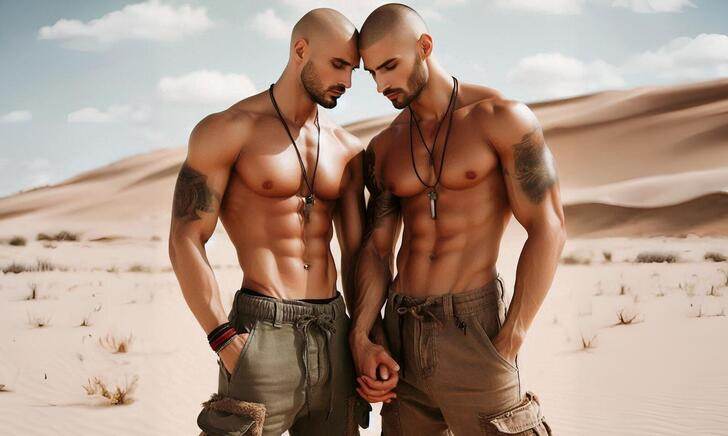Androphilia is the romantic or sexual attraction to men or masculinity. Unlike other terms that are often bound by gender or sexual orientation, androphilia encapsulates a broader concept - it's about who someone is attracted to, without making assumptions about their own gender identity.
Historically, the concept of androphilia has been present in various forms across different cultures. In ancient Greece, for example, relationships between men were often seen as an expression of intellectual and emotional intimacy. Similarly, various indigenous cultures had recognized and respected various forms of gender and sexual diversity long before Western influences. Knowing these historical contexts give us a richer perspective on androphilia today.
It's good if you can make a distinction between androphilia and gynephilia. Androphilia refers to an attraction to men, while gynephilia refers to an attraction to women. These terms help in discussing attraction without automatically assuming the gender identity of the person experiencing it.
Biological and psychological factors influence androphilia; On one hand, genetics may contribute to one's sexual preferences. On the other, psychological factors, such as early life experiences and emotional connections, also shape one's attraction. While it may never be entirely clear how these factors interplay, it’s evident that androphilia is multifaceted and deeply ingrained in human experience.
Androphilia Across Cultures and Time
Exploring the presence of androphilia in ancient civilizations reveals a complex tapestry of acceptance and practice. In ancient Greece, relationships between men were often celebrated for fostering intellectual and emotional bonds. Similar patterns were observed in some Native Ameri tribes, where two-spirit people, men embodying masculine traits, held respected roles in their societies.
Cultural attitudes towards androphilia have varied drastically across time and geography. While some cultures honored or accepted it, others perceived it as taboo. For instance, during the medieval period in Europe, the perception of same-sex relationships shifted hugely owing to the influence of religious doctrines.
Religion has long played a critical role in shaping societal norms regarding androphilia. In many Abrahamic religions, texts have been interpreted in ways that stigmatize same-sex attraction. However, other spiritual traditions and belief systems tend to be more inclusive or neutral concerning androphilia, reflecting a wide spectrum of acceptance.
Notable historical figures linked with androphilia include poets, priests and politicians, as Sting used to say. And of course, artists whose relationships with men often influenced their work and legacies. For example, the renowned poet Walt Whitman is often discussed within the context of androphilic themes, and his writings provide rich insights into his perspectives and experiences.
Knowing these varied cultural landscapes helps foster empathy and awareness. This diverse historical context challenges modern stereotypes and offers a broader figuring out of human relationships.
Best Seller: Xtend BCAA + Recovery

We earn a commission if you click this link and make a purchase at no additional cost to you.
The Science Behind Androphilia
The study of androphilia through a scientific lens provides fascinating insights into human sexuality. Genetic factors play a role. Male siblings of gay men are statistically more likely to be gay themselves, suggesting a hereditary component. Hormonal influences during prenatal development also come into play. Some studies propose that exposure to specific hormone levels in the womb affect future sexual orientation.
Psychological perspectives offer another layer of figuring out. Freud's early theories about human sexuality touched on the fluid nature of attraction, though many of his ideas have been debated. Modern psychology looks at a combination of cognitive, emotional, and social factors. Childhood experiences, emotional bonds, and the surrounding environment all contribute to shaping one's attractions.
Evolutionary theories on androphilia suggest that it may have had adaptive value in human history. For example, strong bonds between men could have promoted group cohesion and survival. Although this is speculative, it adds an interesting dimension to the discussion of human sexuality.
The intersection of gender identity and sexual orientation is also crucial. While androphilia pertains to attraction to men, it doesn't dictate the androphilic men's own gender identity. This intersection is especially fabulous in figuring out the diverse spectrum of human experiences. Transgender men, for instance, may also experience androphilia, adding to the variations and richness of human sexuality.
Modern Perspectives on Androphilia
Today's representation of androphilia in media and popular culture is more visible than ever before. Movies, TV shows, and literature are increasingly featuring androphilic characters, providing a platform that normalizes diverse sexualities. Shows like 'Queer Eye' and movies like 'Call Me by Your Name' highlight the experiences and emotions associated with androphilia, allowing broader audiences to connect and empathize.
Despite these advances, legal rights and social justice issues remain at the forefront for many androphilic gays. In numerous countries, same-sex relationships are still criminalized, and even where legal protections exist, social acceptance lag. Advocating for equal rights and fighting discrimination are ongoing struggles that require collective efforts from allies and the affected communities.
Androphilic gays face unnecessary difficulties. Societal prejudices, lack of knowledge, and internal conflicts create emotional and mental health burdens. Mental health support, inclusive education, and open dialogues are crucial in addressing these issues. It's vital to recognize these challenges and offer the necessary support, ranging from counseling services to community support groups.
Support systems and resources play a transformative role. Organizations like The Trevor Project provide crisis intervention and suicide prevention services specifically for queer youth, including those who are androphilic. Local LGBTQ+ centers offer safe spaces for connection and community-building, creating environments where gay men thrive authentically and safely.




